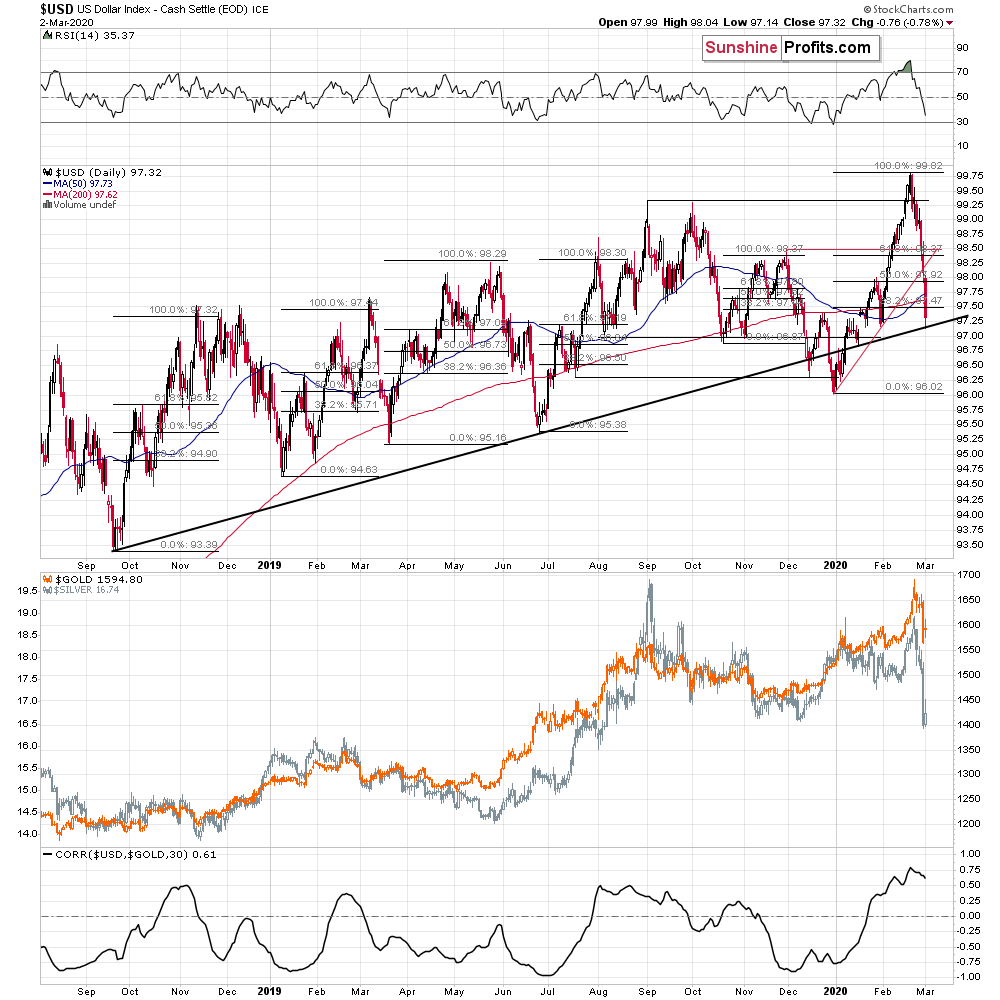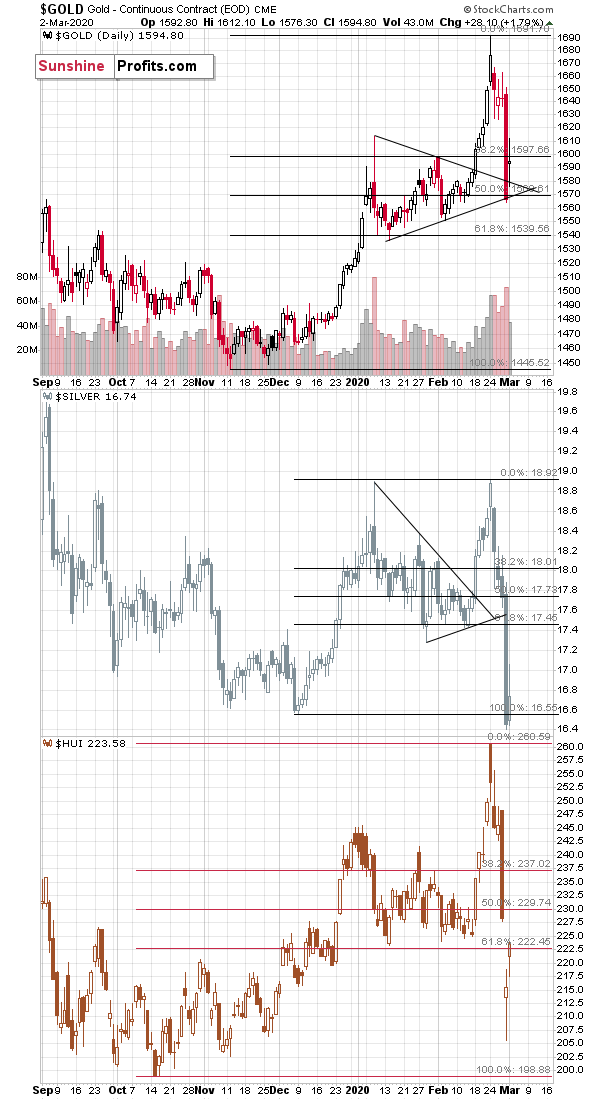Briefly: in our opinion, full speculative short positions (250% of the regular position size) in gold, silver, and mining stocks are justified from the risk/reward point of view at the moment of publishing this Alert.
Yesterday's Alert was extensive and covered the analysis of the precious metals market from many angles. Since nothing major happened in gold, silver, or mining stocks during yesterday's session, the points that we made yesterday remain up-to-date and thus today's technical part will be relatively shorter. We will make additional comments on the interest rates and the analogy to 2008 and 2000, though.
The technical thing that did change, was the USD Index chart, which shows USD's yet another powerful slide. And that happened regardless of the greenback having already reached a combination of support levels previously. What does it mean?
The USDX Reflection on PMs
The less important thing is that the USDX might have finally reached the bottom yesterday, as it visited the rising, medium-term support line and the late-January lows. The RSI indicator close to 30 is where the USDX used to reach its previous short-term bottoms. It's at 35 right now, suggesting that the downside here is very limited.
The more important thing is how did the precious metals sector respond to the big show of weakness (-0.76 index point slide in one day is quite something). It barely moved.
The move higher in silver was almost nonexistent compared to the huge slide on Friday, and the move in gold was a regular rebound - a breather.
In many cases, gold's $28 upswing would be viewed as something significant. But not yesterday, as such moves should be considered on a relative basis. Compared to how volatile gold was on Friday, and how much it dropped, it "should have" erased at least half of the preceding decline, preferably more. And it should have done away with a sizable portion of our profits (we entered the short positions in gold, silver, and mining stocks on Feb 21st). Gold was unable to do that.
This tells us that yesterday's move was most likely just a breather within a decline, not the profound comeback after a major bottom. And it tells us that one should at least consider postponing their gold investments right now.
The upswing that we see in mining stocks might seem more encouraging, but we don't trust it either. Miners didn't erase their Friday's decline, even though the other stocks (S&P 500) did. In fact, S&P 500 almost erased Friday's and Thursday's decline with yesterday's rebound. Miners were not even close to doing the same thing as the general stock market.
What miners did, was actually a comeback to the previously broken levels - the previous 2020 lows. The breakdown below them seems to be verified. Once this process is completed, the decline is likely to resume.
Please note that the market is expecting at least a 0.5% rate cut in March. Based on CME's FedWatch tool, the probability of at least a 0.5% cut is 100%. This means that a 0.5% cut might even be viewed as hawkish and thus not trigger a rally in PMs, or cause further decline in the USDX. The markets expect (73.9%) the Fed to then cut rates once again in April (or to cut it by 0.75% in March and not to cut in April).
The rates are likely to decline and yet PMs are still declining. Doesn't that remind you of something?
The Fed started to cut rates in mid-2007. Gold moved higher and topped in early 2008. Then it started one of the biggest and sharpest declines of the previous decades. And it did so despite the rates declining at a faster pace. The rates bottomed at the end of 2008, but gold bottomed earlier. Also, the USD Index declined at first (between mid-2007 and early 2008) but then it soared by about 16 index points in just a few months (despite the downtrend in interest rates). And we've been writing about dollar's upside potential for months.
Now, the Fed started to cut rates in mid-2019. Gold moved higher and topped in early 2008. The rates were not cut once again yet, but it's almost certain that they will be cut given the market's expectations, so we practically know that the decline in rates is likely to accelerate. And yet, gold is not reacting by rallying anymore.
The similarity to 2008 is present not only from the technical point of view (which we elaborated on yesterday), but also from the fundamental point of view.
Oh, and there was only one additional analogous situation in case of interest rates. It was between late-2000 and late-2001. Gold bottomed then, but not before declining first. Silver underperformed gold, and it bottomed in late 2001. This analogy is not perfect, though, and is worse than the one to 2008, because of the obvious difference in the performance of gold stocks. In 2008, they magnified gold's declines, while in 2001, they showed great strength. Well, miners are definitely not showing great strength here, so the link to 2008 is much stronger. And the implications are very bearish for the following months.
Summary
Summing up, the 2020 top in the precious metals market is most likely in. Gold declined on record-breaking volume, while silver and miners plunged to new yearly lows - and it happened even before the USD's rally resumed. The outlook for the following months is extremely bearish, and the analogy to 2008 is very strong, also in terms of the likely interest rate moves.
The profits on our big short position in the precious metals market are already sizable, but they are likely to become enormous in the following weeks.
As always, we'll keep you - our subscribers - informed.
To summarize:
Trading capital (supplementary part of the portfolio; our opinion): Full speculative short positions (250% of the full position) in gold, silver, and mining stocks are justified from the risk/reward perspective with the following stop-loss orders and binding exit profit-take price levels:
- Gold futures: profit-take exit price: $1,422; stop-loss: $1,712; initial target price for the DGLD ETN: $33.30; stop-loss for the DGLD ETN: $19.88
- Silver futures: profit-take exit price: $14.63; stop-loss: none (if gold moved to $1,712 we would view silver positions as no longer valid); initial target price for the DSLV ETN: $26.10; stop-loss for the DSLV ETN: none (if gold moved to $1,712 we would view silver positions as no longer valid)
- Mining stocks (price levels for the GDX ETF): profit-take exit price: $20.22; stop-loss: $29.51; initial target price for the DUST ETF: $11.29; stop-loss for the DUST ETF $5.25
In case one wants to bet on junior mining stocks' prices, here are the stop-loss details and target prices:
- GDXJ ETF: profit-take exit price: $28.32; stop-loss: $42.12
- JDST ETF: profit-take exit price: $20.97; stop-loss: $8.89
Long-term capital (core part of the portfolio; our opinion): No positions (in other words: cash)
Insurance capital (core part of the portfolio; our opinion): Full position
Whether you already subscribed or not, we encourage you to find out how to make the most of our alerts and read our replies to the most common alert-and-gold-trading-related-questions.
Please note that the in the trading section we describe the situation for the day that the alert is posted. In other words, it we are writing about a speculative position, it means that it is up-to-date on the day it was posted. We are also featuring the initial target prices, so that you can decide whether keeping a position on a given day is something that is in tune with your approach (some moves are too small for medium-term traders and some might appear too big for day-traders).
Plus, you might want to read why our stop-loss orders are usually relatively far from the current price.
Please note that a full position doesn't mean using all of the capital for a given trade. You will find details on our thoughts on gold portfolio structuring in the Key Insights section on our website.
As a reminder - "initial target price" means exactly that - an "initial" one, it's not a price level at which we suggest closing positions. If this becomes the case (like it did in the previous trade) we will refer to these levels as levels of exit orders (exactly as we've done previously). Stop-loss levels, however, are naturally not "initial", but something that, in our opinion, might be entered as an order.
Since it is impossible to synchronize target prices and stop-loss levels for all the ETFs and ETNs with the main markets that we provide these levels for (gold, silver and mining stocks - the GDX ETF), the stop-loss levels and target prices for other ETNs and ETF (among other: UGLD, DGLD, USLV, DSLV, NUGT, DUST, JNUG, JDST) are provided as supplementary, and not as "final". This means that if a stop-loss or a target level is reached for any of the "additional instruments" (DGLD for instance), but not for the "main instrument" (gold in this case), we will view positions in both gold and DGLD as still open and the stop-loss for DGLD would have to be moved lower. On the other hand, if gold moves to a stop-loss level but DGLD doesn't, then we will view both positions (in gold and DGLD) as closed. In other words, since it's not possible to be 100% certain that each related instrument moves to a given level when the underlying instrument does, we can't provide levels that would be binding. The levels that we do provide are our best estimate of the levels that will correspond to the levels in the underlying assets, but it will be the underlying assets that one will need to focus on regarding the signs pointing to closing a given position or keeping it open. We might adjust the levels in the "additional instruments" without adjusting the levels in the "main instruments", which will simply mean that we have improved our estimation of these levels, not that we changed our outlook on the markets. We are already working on a tool that would update these levels on a daily basis for the most popular ETFs, ETNs and individual mining stocks.
Our preferred ways to invest in and to trade gold along with the reasoning can be found in the how to buy gold section. Additionally, our preferred ETFs and ETNs can be found in our Gold & Silver ETF Ranking.
As a reminder, Gold & Silver Trading Alerts are posted before or on each trading day (we usually post them before the opening bell, but we don't promise doing that each day). If there's anything urgent, we will send you an additional small alert before posting the main one.
Thank you.
Sincerely,
Przemyslaw Radomski, CFA
Editor-in-chief, Gold & Silver Fund Manager






